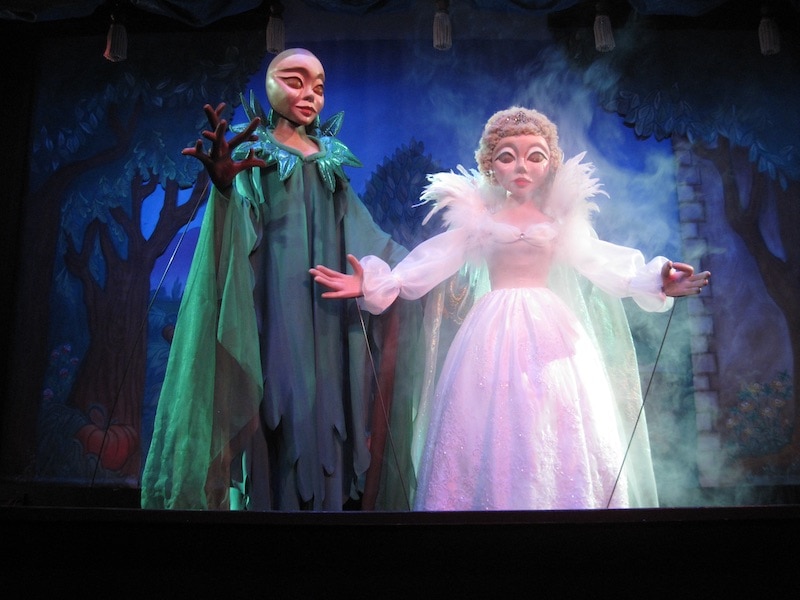Sometimes when doing things with children, it’s nice to go the old-fashioned way, to get a break from screens, electronics, and frantic over-scheduling and experience a little gently paced and traditional magic.

Cinderella, the current show at The Puppet Co., is just the ticket. The specially designed theater resides in the Arcade building on the grounds of Glen Echo Park, now a National Park Service property, but from the early 1900s to 1968 the premiere amusement park in the DC area. In restored Art Deco buildings and a collection of yurts (because, why not?), the park now houses a vibrant arts community managed by the Glen Echo Park Partnership for Arts and Culture and presents a wealth of visual arts and crafts exhibits, demonstrations and classes, two children’s theaters, and a dance program.
After one walks (or runs, depending on age) from the parking lot, through the woods, over a stream, and by a pirate ship playground in front of the aquarium center, the Puppet Co. theater is cool and dim, like a cave of wonders. A large open area in the center with soft carpeting accommodates the young audience who want to sit close to the stage while surrounding banks of cushioned benches welcome grateful grown-up companions.

The raised stage is designed with curtains on the bottom and a performing space on the top, but it looks like the arrangement could be reversed, depending on whether the puppets performing that day are marionettes or rod puppets, controlled, muppet-like, by sticks from below. For Cinderella they are the latter. They are large — almost the same height as some of their smaller patrons — the better to be seen and marveled at by the pint-sized audience.
The puppet actors are amazingly expressive. Even though they cannot alter their facial expressions — except for Cinderella’s cat, archly named “Prince Charming,” whose eyebrows move on their own! — they can convey emotion with a tilt of a chin or a hand. Apparently, these puppets’ heads are loose on top of the sticks that hold them up, and the talented puppeteers can control them with strings running down alongside the main rod, while also managing to make them walk or even waltz, move their arms and turn their hands to convey different feelings. The Stepmother’s haughty high-held head and very slow and stately walk convey her cold cruelty. Cinderella shows her disappointment by drooping her head and indicates when she’s had enough by the defiant tilt of her chin. The puppets can curtsey gracefully, faint, scrub the floor, and even pick up Cinderella’s mop bucket, which the Prince tries gallantly to carry for her but finds too heavy, while she has no trouble at all. When Prince Charming (the suitor, not the cat, there is some comic confusion about that) finally gets to kiss Cinderella — we’re not worried about spoilers, here, are we? — he charmingly puts his hand on her cheek.
There are a few hints of modernity in the story. The Prince first falls in love with Cinderella because she is kind to him when she thinks he is just a poor hunter lost in the forest, and then again when he meets her at the ball. When the Fairy Godmother is creating Cinderella’s coach with some nifty smoke effects, she very politely asks the cat for permission to poof him into a coachman. After the ball, when the Stepsisters have been unable to fit the glass slipper on their comically oversized feet, the Stepmother tries to keep Cinderella hidden away. But Ella stands up to her, reclaims her name, and demands to try on the slipper. And in the end, Cinderella’s hapless father, realizing that he has lost the daughter who loved him and is stuck with his new wife and her brood, executes a very contemporary facepalm.

The show is just the right mix of old-fashioned fairytale and updated girl power, and the young audience loves it. And in one more concession to modernity, Prince Charming emerges after the show to ad lib and take selfies with the guests.
Afterward, visitors can wander around the theater looking at creations from the Puppet Co’s nearly four-decade history, both rod puppets and marionettes, and marvel at the workmanship close up.
And then, to continue the magic, they can wander back out into the park, get some ice cream or a pastry at the bakery, and take a ride on the beautiful, century-old Dentzel Carousel, where the carved wooden horses resemble the puppets they just saw.
Cinderella at The Puppet Co is like a trip back in time — with nice, modern air conditioning. It’s sure to have something to please everyone.
Running Time: Approximately 45 minutes.
Recommended ages 5+.
Cinderella plays through August 28, 2022 — Thursdays and Fridays at 10:30 am, Saturdays and Sundays at 11:30 am and 1 pm — at the Puppet Co. Playhouse, Glen Echo Park, 7300 MacArthur Boulevard, Glen Echo, MD. An ASL interpretation* of the show is available on August 21 at 11:30 am. Tickets ($15) are available online. (No ticket is required for those under age 2, but call the Box Office to reserve a free ticket.) For information call 301-634-5380 or email [email protected].
COVID Safety: All those over the age of 2 are required to mask inside at all times.
*At all special event performances, all patrons over the age of 5 need to show proof of vaccination for admission. For more information, see FAQs here.




